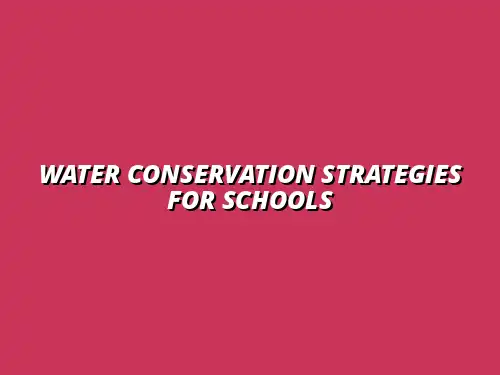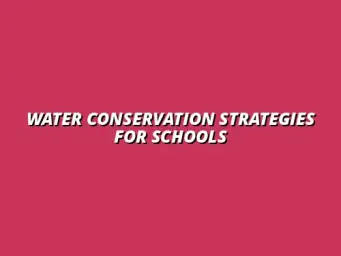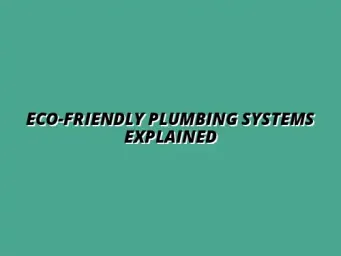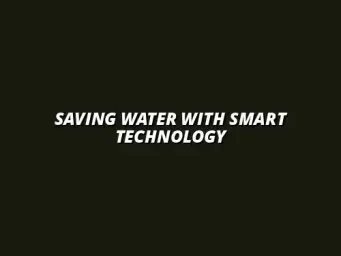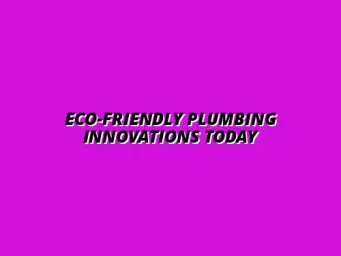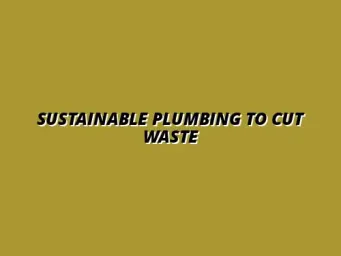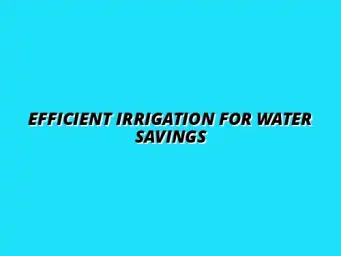Understanding the Importance of Water Conservation in Schools
Water is essential for our everyday lives, and schools are not exempt from the need to conserve this precious resource. As educational institutions, schools must recognize their role in promoting water conservation practices. By instilling these values in students, schools prepare them to be responsible global citizens who understand the impact of their actions on the environment. Implementing effective water conservation strategies at home can also make a significant difference; check out these water-saving tips for your home to learn more.
With increasing water scarcity affecting many regions, it’s crucial for schools to implement effective strategies to manage their water usage. Not only does this help in alleviating pressure on local water supplies, but it also sets a positive example for students. In this way, schools can contribute to a more sustainable future while enhancing their educational mission. For example, understanding the benefits of water-efficient irrigation can significantly impact water usage on school grounds.
The Impact of Water Scarcity on Educational Institutions
Water scarcity can significantly hinder a school's operations. When water is limited, it can lead to a range of challenges, including disrupted sanitation services, restricted access to clean drinking water, and limitations on outdoor activities. These obstacles can negatively affect both student health and academic performance, making it essential for schools to address these issues proactively. Regular water pressure checks are crucial for identifying potential leaks and maximizing efficiency.
Moreover, water scarcity can strain school budgets as institutions may need to invest in costly water procurement solutions. This financial burden can divert resources away from vital educational programs and infrastructure improvements. Thus, understanding the implications of water scarcity not only highlights the need for conservation but also underscores the importance of effective water management in schools. Simple changes in daily habits can significantly reduce water waste; discover helpful daily tips to reduce water waste.
Challenges Faced by Schools Due to Water Shortages
Schools encounter various challenges when dealing with water shortages, including:
- Increased operational costs: Schools may face higher expenses to secure water supplies.
- Health risks: Limited access to clean water can lead to hygiene and sanitation issues.
- Reduced outdoor learning opportunities: Lack of water for irrigation limits recreational spaces.
- Disruption of daily activities: Water shortages can interrupt basic school functions.
Addressing these challenges requires a comprehensive approach that involves both immediate solutions and long-term planning. By identifying these issues, schools can take steps to minimize their impact and promote a culture of water conservation. Proper water heater maintenance is also a key factor in efficient water usage.
The Role of Schools in Promoting Sustainable Practices
Schools play a vital role in fostering sustainable practices among students and staff. By being proactive in water conservation, educational institutions can create an environment that encourages responsible use of resources. This includes not only reducing water waste but also promoting awareness of sustainability concepts in daily activities. Conserving water in the bathroom is a great starting point; learn more about conserving water with bathroom plumbing tips.
To effectively promote sustainable practices, schools can implement various initiatives, such as:
- Education programs: Teach students about the significance of water conservation.
- Community partnerships: Collaborate with local organizations to enhance conservation efforts.
- Student involvement: Engage students in projects focused on water-saving techniques.
- Monitoring and reporting: Track water usage and share progress with the school community.
Through these initiatives, schools can ensure that water conservation becomes a shared value and responsibility, allowing students to grow into environmentally conscious adults. Simple, effective water-saving tips for your home can be easily adapted for school settings.
Key Water Conservation Strategies for Educational Facilities
To make a real difference in water conservation efforts, schools must adopt and implement effective strategies tailored to their unique needs. By focusing on efficient management systems and innovative technologies, educational institutions can significantly reduce their water consumption while setting an example for students and the community.
Here are some key strategies that schools can consider when looking to enhance their water conservation efforts:
- Implementing efficient water management systems
- Utilizing smart irrigation technologies
- Integrating rainwater harvesting systems
- Enhancing awareness and education on water conservation
- Upgrading infrastructure for sustainable water use
By exploring these strategies further, schools can take significant steps towards a more sustainable future, benefiting both their students and the environment.
Measuring the Effectiveness of Water Conservation Strategies in Schools
To ensure that our efforts in conserving water are actually making a difference, we need to measure their effectiveness. This involves setting clear goals and diligently tracking our progress over time. By doing this, we can spot what works well and what might need tweaking!
When we set specific objectives, it provides a clear direction for everyone involved. It’s not just about saving water; it’s about understanding how those changes affect our schools and communities overall.
Setting Goals and Tracking Progress
Establishing effective goals is the first step in measuring the success of any water conservation strategy. We should focus on creating Key Performance Indicators, or KPIs, that help us track our water usage. These KPIs can make it easier to understand if our initiatives are actually leading to reduced water consumption.
- Reduce overall water consumption by 20% over the next year.
- Implement a monthly water usage report to monitor progress.
- Train staff and students on water-saving practices to increase engagement.
Alongside these goals, utilizing data analytics can play a significant role. By analyzing our water usage data, we can spot trends and make informed decisions that lead to continuous improvement.
Establishing Key Performance Indicators for Water Use
Key Performance Indicators (KPIs) give schools a clear framework for measuring the impact of their water conservation initiatives. These indicators can include metrics such as:
- Monthly water bill amounts.
- Water usage per student.
- Rainwater collected from harvesting systems.
Tracking these KPIs allows us to see real-time results and adjust our strategies as needed. It's like having a report card for our water usage!
Utilizing Data Analytics for Continuous Improvement
Data analytics can really enhance our understanding of water usage in schools. By gathering data from various sources, we can track the effectiveness of our conservation efforts and pinpoint areas where we can improve.
Some useful methods include:
- Using smart meters to monitor water flow.
- Analyzing historical data to identify usage patterns.
- Regularly reviewing the data with staff and stakeholders to ensure accountability.
This information can help us make informed decisions and refine our practices for even better water conservation results.
Evaluating the Impact on the School Environment
Once we have set goals and begun tracking our progress, it’s time to evaluate the impact of our water conservation strategies on the school environment. This evaluation is crucial for understanding how effective our initiatives have been!
One major factor to consider is how water consumption patterns change over time. If we notice a consistent decrease in usage, it’s a strong indicator that our efforts are paying off.
Assessing Changes in Water Consumption Patterns
Assessing changes in water consumption can be as simple as reviewing monthly water usage reports. Here are some ways to evaluate these changes:
- Compare current usage to past records.
- Identify specific areas where reductions have occurred, like irrigation or restroom facilities.
- Analyze seasonal variations in water usage and adjust strategies accordingly.
Such assessments help us understand which initiatives are most effective and deserving of further investment.
Gathering Feedback from Students and Staff on Initiatives
Another way to measure the effectiveness of our water conservation strategies is by gathering feedback from those directly involved—students and staff! Their insights can provide valuable information about the practicality and reception of our initiatives.
We can gather feedback through:
- Surveys and questionnaires focused on water-saving measures.
- Conducting focus groups to discuss the challenges faced.
- Encouraging open forums for sharing ideas and experiences.
This feedback loop promotes a strong sense of community and shared responsibility, making everyone feel part of the solution!

